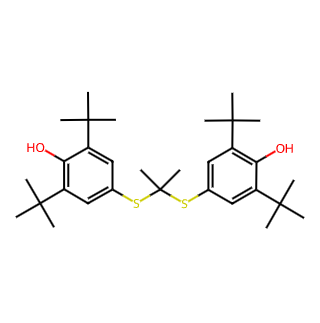- Synthetic anti-infective drugs
- Medications for the digestive system
- Antipyretic and analgesic drugs
- Medications for the blood system
- Medications for the respiratory system
- Anti-allergic drugs
- Medications for the urinary system
- Diagnostic medications
- Immunosuppressive and immunomodulatory drugs
- Vitamins and mineral supplements
- Antioxidants and medications for osteoporosis
- Antiparasitic drugs
- Ophthalmic medications
- Amino acids and their derivatives
- Dermatological medications
- Medications for the circulatory system
- Antitumor drugs
- Medications for the nervous system
- Hormonal and endocrine function-regulating drugs
- Antibiotics
- Others
CAS NO.: 23288-49-5




Basic Information
Chinese Name: 普罗布考
English Name: Probucol
Alternative Names: 4,4'-[(1-Methylethyl)disulfide]bis[(2,6-di-tert-butyl)phenol]; 2,2-Propylidene-bis[4-thio-2,6-di-tert-butylphenol]; Lorelco; Lurselle
CAS Number: 23288-49-5
EINECS Number: 245-560-9
Molecular Formula: C31H48O2S2
Molecular Weight: 516.84
Physical Properties
Melting Point: 125-128°C (may vary slightly depending on the solvent used for recrystallization)
Boiling Point: Approximately 571.58°C (estimated)
Density: 1.0008 (estimated)
Refractive Index: 1.5341 (estimated)
Solubility: Slightly soluble in chloroform and ethyl acetate
Chemical Properties
The molecular structure of Probucol contains two phenolic hydroxyl groups that are prone to oxidation, giving it a strong ability to capture oxygen ions. The phenolic hydroxyl groups form stable phenoxy radicals when combined with oxygen ions.
The phenolic hydroxyl groups are lipophilic and are primarily distributed on the surface of lipoprotein particles, consisting of phospholipids and free cholesterol.
Pharmacological Effects
Lipid-regulating Effect: Probucol reduces cholesterol synthesis and promotes cholesterol breakdown, leading to decreased blood cholesterol and low-density lipoprotein levels. It also modifies the properties and functions of high-density lipoprotein subtypes, with minimal effects on blood triglycerides.
Antioxidant Effect: Probucol significantly inhibits the formation of foam cells, delays the development of atherosclerotic plaques, and can regress established atherosclerotic plaques. Its antioxidant effect is 5-6 times that of vitamin E, 16 times that of nimodipine, 95.5 times that of verapamil, and 104 times that of captopril.
Other Effects: Probucol also exhibits potent anti-aging effects and can be used to treat restenosis after vascular angioplasty.
Indications
Clinically, Probucol is suitable for various types of mild to moderate hyperlipidemia and can be combined with other drugs in the treatment of severe hyperlipidemia.
It is used in high-risk patients with atherosclerosis and provides protection against oxidative stress in arterial wall cells (endothelial cells), leading to the regression or disappearance of atherosclerotic plaques.
Storage Conditions
Store in a cool, dry, and well-sealed environment, protected from direct sunlight.

Tai Yau Street, San Po Kong, Kowloon, Hong Kong, China.



